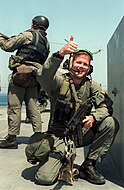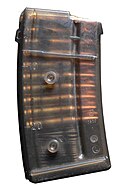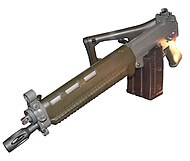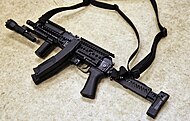Jungle style

Firearm magazines are used "jungle style" if they are fixed together side by side, often with tape. The spare magazine may be pointing downwards in relation to the one fitted to the weapon.
This configuration is used to speed up the process of reloading, since a loaded magazine is attached to the one in use. Disadvantages include an increase in the risk of stoppages due to the exposure of the rounds and magazine lips to dirt (particularly if the second magazine is inverted), possible loss of ammunition, and that the extra length of two magazines together can raise the profile of a soldier in the prone position.
To counter these drawbacks, some manufactures, such as SIG and Heckler & Koch,[1] have designed magazines with studs and cradles which permit extra ammunition to be carried parallel mated in an upright position without the need for tape or clamps.[1]
History
[edit]The practice of "jungle style" magazines originated in World War II for the M1 carbine,[2] M3 "Grease Gun",[3] and Thompson submachine gun.[4] Audie Murphy, one of the most decorated American combat soldiers of World War II, was reported to have utilized taped M1 carbine magazines.[5]
Thompson submachine gun users frequently taped two 20-round magazines together to speed reloads and compensate for the limited capacity. This spurred official development of the 30-round Thompson magazine, which included the experiment of welding two 20-round magazines face-to-face (dropped in favor of the 30-round magazine). The United Defense M42 submachine gun was occasionally issued with two 20-round magazines welded face-to-face.[6]
Taping magazines together in order to speed up reloading became so common among troops using the M1 Carbine that the U.S. military experimented with the "Holder, Magazine T3-A1", which came to be referred to by some infantrymen as the "Jungle Clip". This metal clamp holds two M1 Carbine 30-round magazines together without the need for tape.[7]
Advantages and disadvantages
[edit]Jungle style magazines provide the fastest magazine change possible as the operator does not have to reach for a spare magazine carried on their body. Tactical reloads are also much faster with jungle style magazines. Two 30 round AR-15 magazines coupled together, for example, is often a cheaper and more reliable alterative to a 60 round drum magazine, especially for something like home defense.
However, jungle style magazines can often be impractical as it exposes the rounds and feed lips to foreign objects like mud and dirt which can cause malfunctions. Additionally, the rifle becomes much heavier with the addition of a loaded magazine. Due to their inherent layout, they are also more cumbersome to store in magazine pouches and dump pouches.
Image gallery
[edit]-
U.S. Navy SEAL with MP5 SMG and two magazines clamped together during Operation Desert Storm in 1991.
-
Detachable box magazine for a SIG 550 with studs for stacking multiple magazines together.
-
SIG SG 551 with three magazines held together.
-
Vityaz-SN with a fastening device that joins two magazines together.
-
Two Ruger 10/22 magazines attached.
-
Two 15-round M1 Carbine magazines attached by a clip.
-
A United Defense M42 with magazines welded together.
References
[edit]- ^ a b Terry Gander, ed. (2006). Jane's Infantry Weapons 2006/2007. Jane's Information Group. pp. 179, 220. ISBN 0710627556.
- ^ Leroy Thompson (2011). The M1 Carbine. Bloomsbury USA. p. 57. ISBN 978-1849086196.
- ^ Michael Green (2015). United States Infantry Weapons of the Second World War: Rare Photographs from Wartime Archives. p. 68.
- ^ Bill Yenne (2009). Tommy Gun: How General Thompson's Submachine Gun Wrote History. Macmillan. p. 212. ISBN 978-0312383268.
- ^ "Audie Murphy's M1 Carbine Gift To DFC Recipient George D. Mclvor". December 19, 2012. Retrieved December 22, 2015.
- ^ Eugene Liptak (2009). Office of Strategic Services 1942-45: The World War II Origins of the CIA. Osprey Publishing. ISBN 978-1846034633.
- ^ "M1 Carbine" (PDF). Camden Light Artillery 1 BN. Camden Light Artillery Association and the 1st Battalion 112th Field Artillery. December 2017. p. 6. Retrieved Feb 12, 2021.








